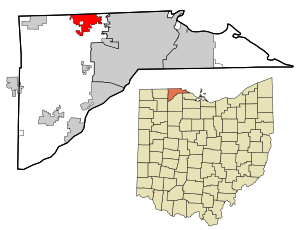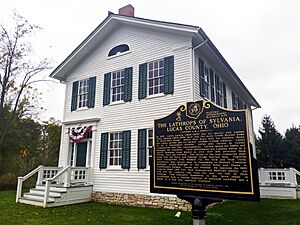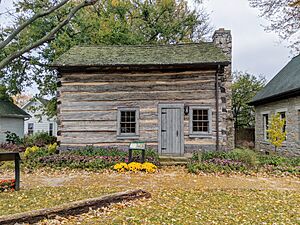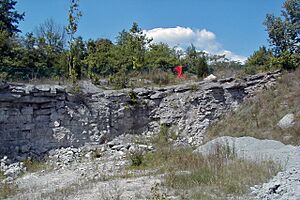Sylvania, Ohio facts for kids
Quick facts for kids
Sylvania, Ohio
|
|||
|---|---|---|---|

Main Street, downtown Sylvania
|
|||
|
|||
| Nickname(s):
City of Trees
|
|||
| Motto(s):
"Serving the Community"
|
|||

Location in Lucas County and the state of Ohio.
|
|||
| Country | United States | ||
| State | Ohio | ||
| County | Lucas | ||
| Area | |||
| • Total | 6.72 sq mi (17.40 km2) | ||
| • Land | 6.67 sq mi (17.26 km2) | ||
| • Water | 0.05 sq mi (0.14 km2) | ||
| Elevation | 646 ft (197 m) | ||
| Population
(2020)
|
|||
| • Total | 19,011 | ||
| • Density | 2,852.36/sq mi (1,101.26/km2) | ||
| Time zone | UTC-5 (Eastern (EST)) | ||
| • Summer (DST) | UTC-4 (EDT) | ||
| ZIP code |
43560
|
||
| Area code(s) | 419 | ||
| FIPS code | 39-76022 | ||
| GNIS feature ID | 2396020 | ||
Sylvania is a city located in Lucas County, Ohio, in the United States. About 19,000 people lived there in 2020. Sylvania is a suburb of Toledo. It is surrounded by Sylvania Township. The state of Michigan is just north of Sylvania.
The name "Sylvania" comes from a Latin word meaning "forest land." This is because the area was once covered by thick forests. These forests were part of a huge wetland called the Great Black Swamp.
Contents
Sylvania's Story: How It Began
General David White is known as the founder of Sylvania. He was the first pioneer to settle there. White came from Palmyra, New York. In 1832, he became a General. This title may have been given to him after his service in the War of 1812. It allowed him to explore the western Lake Erie area.
White saw that some land north of Maumee, Ohio had great potential. Maumee was an important port city back then. He bought the land and built a log cabin. This cabin was located near what is now downtown Sylvania.
Early Land Deals and Disputes
Before White bought the land, it was part of Port Lawrence Township. This area was in Monroe County, Michigan. Over several years, White and his friend, Judge William Wilson, bought a lot of land. They bought about 1,920 acres in what became Sylvania. They also bought 1,720 acres in what became Whiteford Township, Michigan. White was also the first town supervisor in Whiteford.
White and Wilson's friendship did not last. In 1834, a border dispute started. This dispute was called the Toledo War. It was mostly peaceful. White and Wilson began to divide the lands they had bought. They each planned their own towns. White started the first school in Whiteford in 1834. He also planned the township there in 1835. Wilson presented the first plan for Sylvania in June 1836. The town of Whiteford was right next to it.
Railroads and Growth
In the 1830s and 1840s, train travel grew a lot. This happened all over the Great Lakes region. In 1833, the Erie and Kalamazoo Railroad was started. It was part of the Lake Shore and Michigan Southern Railway. This railroad ran from Port Lawrence, Michigan (now Toledo, Ohio), to Lake Michigan. At first, horses pulled the trains. The first steam train arrived in 1837.
Sylvania built its own train station in 1858. It was along the Erie-Kalamazoo Railroad. The station is no longer used for trains. But the original building is still there. It is now an exhibit in the Sylvania Historical Village. The railroad tracks are still used today.
Sylvania officially became a city in 1867. A post office has been in Sylvania since 1859.
Sylvania's Location and Nature
Sylvania is about 10 miles west-northwest of Toledo. The city covers about 6.68 square miles. Most of this area is land (6.63 square miles). A small part is water (0.05 square miles).
The city is located where two creeks meet. One is Ottawa Creek. It flows south from Ottawa Lake, Michigan. This is about four miles north of Sylvania. The other is Ten Mile Creek. It flows about 30 miles from the west. Ten Mile Creek flows into Ottawa Creek. Ottawa Creek then becomes the Ottawa River. This river empties into the Maumee River.
The city is built on large layers of shale rock. For hundreds of years, this shale has been dug up in quarries. It is used to make concrete, cement, and other stone products. The shale from this area is famous among scientists who study fossils. It has high-quality fossils from the early Devonian period.
People of Sylvania
| Historical population | |||
|---|---|---|---|
| Census | Pop. | %± | |
| 1880 | 523 | — | |
| 1890 | 545 | 4.2% | |
| 1900 | 617 | 13.2% | |
| 1910 | 1,002 | 62.4% | |
| 1920 | 1,222 | 22.0% | |
| 1930 | 2,108 | 72.5% | |
| 1940 | 2,199 | 4.3% | |
| 1950 | 2,433 | 10.6% | |
| 1960 | 5,187 | 113.2% | |
| 1970 | 12,031 | 131.9% | |
| 1980 | 15,556 | 29.3% | |
| 1990 | 17,301 | 11.2% | |
| 2000 | 18,670 | 7.9% | |
| 2010 | 18,971 | 1.6% | |
| 2020 | 19,011 | 0.2% | |
| 2021 (est.) | 19,034 | 0.3% | |
| Sources: | |||
In 2010, there were 18,971 people living in Sylvania. There were 7,642 households. About 31.3% of households had children under 18. Most people (92.4%) were White. About 2.7% were African American, and 2.3% were Asian. About 2.9% of the population was Hispanic or Latino.
The average age in Sylvania was 42.7 years. About 23.6% of residents were under 18. And 17.2% were 65 or older. There were slightly more females (52.7%) than males (47.3%).
Fun Things to See and Do

- The Lathrop House was built in 1853. It was used by abolitionists to help slaves escape to freedom. This house was a stop on the Underground Railroad. Escaping slaves were given food and shelter in a secret room. This room was hidden behind an oven door. The house is recognized as an important historical building. It was moved to Harroun Park in 2002.
- The Harroun Family Barn was built in 1858. The Harroun family also helped slaves on the Underground Railroad. They would hide them in their basement. Then they would help them travel into Michigan. The Harroun property was connected to the Lathrop house by a ravine.
- The Sylvania Historical Village is an open-air museum in downtown Sylvania. It has both original and copied historical buildings. These include the old railroad depot and an 1800s log home.
- Fossil Park opened in 2001. Visitors can break apart loose shale rock from a nearby quarry. This rock often contains amazing fossils, like trilobites. It is one of only two places in the world where visitors can search for fossils themselves. You don't need to be a paleontologist to join in the fun!
- The Burnham Building was once Burnham High School. It was built in 1927. It served as a high school until 1960. It was used for other purposes until 2010. Then it was taken down to build the new Maplewood Elementary School.
Special Events
- The Marathon Classic is a big golf tournament. It is part of the LPGA Tour. This event has been held in Sylvania since 1989.
Parks and Outdoor Fun
Sylvania has over 250 acres of parkland. Some of the parks include Olander Park, Harroun Community Park, and Pacesetter Park.
- The Olander Park System (TOPS) has a large 28-acre pond. It also includes other parks like Fossil Park and Sylvan Prairie Park.
- Pacesetter Park has fields for lacrosse, soccer, and baseball.
- Burnham Park has Plummer Pool, which is a public swimming pool.
Many of Sylvania's fun activities are planned by the Sylvania Area Joint Recreation Department (SAJRD). They run several places and parks. This includes Pacesetter, Veterans Memorial, and Burnham parks. They also run a recreation center called Tam-O-Shanter. This center has two ice skating rinks and two indoor soccer fields. You can play indoor sports like soccer, baseball, lacrosse, and ice hockey there. You can also go ice skating.
Sylvania has been named a "Tree City" for over 30 years. This award is given to communities that care for their urban trees. The city's nickname is "City of Trees." This is a direct translation of its name.
In 2016, a steel beam from the World Trade Center was placed in a memorial. This memorial is called the "9/11 First Responders Last Call Memorial." It is located at the Toledo Memorial Park cemetery in Sylvania.
Schools in Sylvania
Public Schools
All public schools in Sylvania are part of the Sylvania City School District.
- Elementary Schools
- Highland Elementary School
- Hill View Elementary School
- Maplewood Elementary School
- Stranahan Elementary School
- Sylvan Elementary School
- Whiteford Elementary School
- Central Trail Elementary School
- Junior High Schools
- Arbor Hills Junior High School
- McCord Junior High School
- Timberstone Junior High School
- High Schools
- Sylvania Northview High School
- Sylvania Southview High School
Private Schools
- Toledo Islamic Academy
- Little Miracles Montessori School
- St. Joseph Elementary & Junior High School
Colleges
- Lourdes University
Libraries
Sylvania has two public libraries. They are branches of the Toledo-Lucas County Public Library. The Sylvania Branch Library is near Northview High School. It was built in the 1950s and updated in 2017. A second library was built in 2016 near Southview High School.
Famous People from Sylvania
- Sam Abell - a photographer
- Alissa Czisny - a two-time U.S. champion figure skater
- Chip Davis - a musician
- Jon Diebler (born 1988) - a basketball player
- Luke Fortner - an Offensive Lineman for the Jacksonville Jaguars
- Gordie Howe - a famous hockey player
- Eric Kripke - a television producer and writer
- Joey Wiemer - an Outfielder for the Milwaukee Brewers
Sister City
Sylvania has a "sister city" relationship with Woodstock, Ontario, Canada. This means they share cultural ties and friendly exchanges.
See also
 In Spanish: Sylvania (Ohio) para niños
In Spanish: Sylvania (Ohio) para niños








